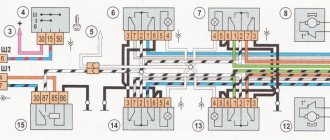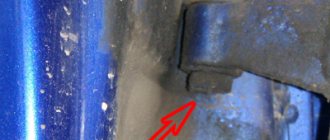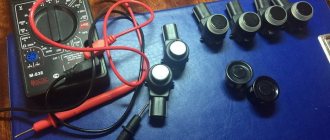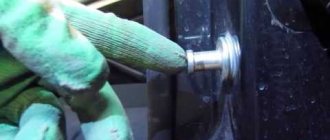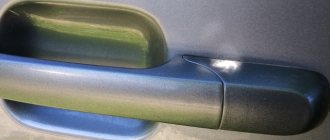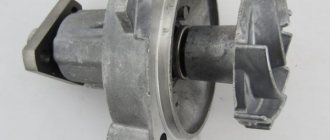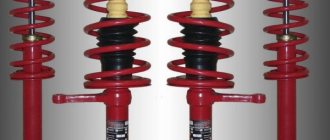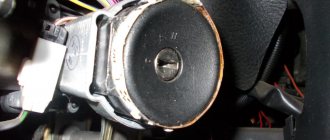Recently, I conducted an experiment where I tested various repair kits for repairing tubeless tires. Based on my observations, I came to the conclusion that even budget sets for a minimum amount do an excellent job of their duties. But what if you puncture a tire and don’t have a repair kit? How to repair a wheel without all kinds of tools. After reading the article, you will learn a simple way to repair a tubeless tire. I'm sure it will be useful to many.
Benefits of repairing tires using a harness
The main advantage of this method is the possibility of repairs in any conditions, including right on the road. An inexperienced driver can handle it; no special skills are required.
The repair kit takes up little space in the car. You can place it in the glove compartment. This is another plus.
Particular attention should be paid to the types of damage that can be repaired in this way. If the tire has a tube installed, the reinstatement tourniquet cannot be used. Cuts in the sidewall and tread cannot be repaired. Sidewall punctures cannot always be repaired with a tourniquet yourself; you need to look at the specifics of the damage.
The harness is also useless if the tire is depressurized. This can happen in the event of a strong and sharp impact on the wheel, for example, hitting an obstacle. In this case, only replacing the wheel will help. It is almost impossible to inflate a tire knocked off a hump without a special compressor.
Emergency sealant for car tires
First of all, we will introduce you to automotive sealants. An affordable product that can be purchased at any gas station.
This morning, as usual, I went down to my car to get to work. From a distance I noticed that one tire was flat. With time running out, I immediately began searching for the hole. The disk was intact, which means I couldn’t get air out of it. The culprit turned out to be a self-tapping screw. He got so deep into the tire that I could barely get him out.
Types of harnesses for tire repair
There are different types of harnesses, they differ in features and technical characteristics.
- Rubber. The simplest option. Consists of raw rubber, sometimes self-vulcanizing rubber is used. When using, you need to be careful; the tourniquet breaks easily.
- Cordovy. Contains cord, synthetic thread. As a result, it is possible to achieve a high level of strength. The cord allows you to repair truck tires.
- Nylon. Expensive type of tourniquet. It is rare and provides a high level of reliability.
When choosing a repair kit, it is optimal to choose options with a cord harness. It is inexpensive and provides effective repairs. Nylon harness is expensive; often it will be cheaper to visit a tire shop.
Another point is the thickness of the harness. The following options are available for sale:
- 3 millimeters;
- 4.5 millimeters;
- 6 millimeters.
The best option would be to use the thickest consumable.
Sometimes you can find patch fungi in repair kits. This “fungus” allows you to seal not only punctures, but also small cuts. Such patches are called “anchors”; the main disadvantage is the high price.
Repairing a punctured tire - test of 16 repair kits and advice from ZR
In ancient times, there was GOST 5170–73 “First aid kits for repairing pneumatic tires.” There were so many components that were not in these first aid kits! And a fungus, and a grater with a plaster, and a roller... And now each manufacturer decides for himself what to put in his kit.
Let's check what the descendants of those travel first aid kits are capable of. Grant's editorial office, one of whose wheels gave up the ghost, pushed for decisive action. Instead of a tire shop, we visited several stores where we purchased 16 different kits for repairing tubeless tires. The price range is sevenfold, although the principle of operation is the same. After finding a puncture, you need to remove the culprit of the problem (screw, nail), then widen the hole and tightly insert a folded rubber band into it. The nuances of technology and tools may vary, but in general the repair algorithm is exactly the same.
Having repaired a tire that encountered a self-tapping screw on the road, we decided to test all 16 repair kits on the poor thing. However, in the end, only 13 stab wounds were inflicted on her, since three sets were immediately rejected: the flagella in them were frankly bad, they instantly tore in the hands.
The instruments also vary quite a bit. Thus, the nice handle in the CityUp CA-793 set managed to rotate relative to the tip during the first attempt to penetrate inside the tire.
Note that some sets do not provide any “picking tools”, and in some places there is no glue. And the names of the instruments are different for almost all manufacturers - in the explanations we give exactly the “proprietary” version.
A tire with so many holes in the tread passed the test at speeds over a hundred for a couple of weeks without losing a drop of precious air. For the sake of the experiment, we didn’t even cut off a few ponytails - and everyone kept it together. We also managed to deal with a small puncture in the sidewall using a flagellum. Although the reliability of sealing is noticeably lower than in the case when the harness is kept in a thick (even a worn tire) tread layer.
Toward the end, they carried out another test - a kind of “everyday” one: they pierced the sidewall of the tire, like some hooligan with a knife or screwdriver. We were no longer engaged in comparative tests, but simply fought for survivability. By the way, the same damage occurs, for example, when the tire comes into hard contact with a curb or the sharp edge of a hole. Such a temporary repair is a priori more difficult: the sidewall is thinner than the tread, and therefore it is more difficult for the flagellum to stay in the hole.
Approximate price:
180 rub.
Equipment:
spiral awl, tool for installing harnesses, strips of raw rubber (5 pieces), adhesive activator
The spiral awl destroys the cord—when installing, you can hear the crackling sound of breaking threads. However, the repaired wheel runs successfully.
Approximate price:
200 rub.
Equipment:
tool for cleaning and forming a hole, an awl with an eye, reinforced strands (5 pieces), glue
The beautiful rasp handle immediately turned - the set can be removed from testing. Okay, we took an analogue of the “picker” from another set... In the end, the wheel was repaired, but I can’t even think of recommending purchasing such a first aid kit.
Approximate price:
540 rub.
Equipment:
tool with a twisted tip, tool with an eye, glue-activator for raw rubber, strips of raw rubber (8 pieces), cutter
The spiral awl is good, the handles are comfortable. Note that the kit includes a cutter; other kits do not have it. I liked the first aid kit, but it was a bit expensive.
Approximate price:
330 rub.
Equipment:
a tool with a twisted tip, a tool with an eye, an adhesive activator for raw rubber, raw rubber flagella (3 pieces)
I didn’t like the picker: it breaks the cord. But the wheel was repaired anyway.
Approximate price:
160 rub.
Equipment:
tool with a twisted tip, tool with an eye, adhesive activator for raw rubber, harnesses (5 pieces)
A tool with a hole like the eye of a needle has a groove that is too wide. Nevertheless, the set passed the test.
Approximate price:
130 rub.
Equipment:
tool for cleaning and forming a hole, an awl with an eye for installing a rope, reinforced ropes (5 pieces), glue
The inexpensive set coped with the task successfully, demonstrating the best price-quality ratio.
What is included in the repair kit
Let's look at what a standard tire repair kit consists of.
- Awl. Has an eyelet at the end. Designed to pull the tourniquet into the damage. Sometimes it may be necessary to pierce a more even hole.
- Rasp. Can be straight or screw. With its help, the puncture is widened and cleaned.
- Glue. Provides connection between the harness and the tire rubber. Sometimes it may be absent, in which case the rubber used in the consumables of the kit is self-vulcanizing.
- Rubber band. May have different thickness.
The above is a standard set. The manufacturer can optionally add various devices to make it easier to repair a tire with his own hands.
Tools and their features
An important role is played by the length of the needle into the eye of which the tourniquet is inserted. A shortened needle allows you to insert the tool into the rubber right up to the handle of the tool, which in this situation is a kind of lock. When working with a needle of a longer size, due to inexperience, you may miss the right moment to stop screwing in time. This may cause the harness to simply fall into the tire.
The sealed packaging reliably protects the activator adhesive from leaking and drying out. Therefore, the lid must have a thread and close tightly.
Equally important is the presence of a brush that will lubricate the flagellum. An excellent option is a brush attached to the lid from the inside. In this case, it is insured against loss and drying out. Otherwise, the owner will be forced to spend extra money on purchasing consumables or apply the vulcanizer with his fingers, which is also not very correct and pleasant.
Do not forget that a timely installed harness not only extends the life of a car tire, but is also able to protect the car and its driver from serious injuries and consequences that can occur due to a flat tire.
*fungus is one of the types of patches, usually rubber, in the form of a nail with a flat, wide head.
Source
How to repair a tire with a DIY harness
Having figured out the completeness of the “first aid kit”, let’s see how to use this set. First you need to ensure safety. The car must be parked on level ground, be sure to set the handbrake. Before work, you need to inflate the tire.
Repairing a tire with a harness occurs in the following order.
- It is necessary to find a puncture. Wet the protector generously with soapy water or other viscous liquid. You can use windshield washer fluid. We determine the puncture by the bubbles that stand out. If a nail or other object has pierced the tire, the rubber does not need to be wetted.
- Use a rasp to widen the puncture. We clean it thoroughly. The better the work is done, the better the repair will be.
- We thread the cord rope through the eye of the awl.
- Lubricate the harness with glue. This should be done immediately before repairs.
- We drag the tourniquet with an awl inside the tire. We remove the awl; the rubber should fill the damage.
Cut off excess rubber. The work is completed.
How to seal a car camera: procedure
To repair a wheel at home, you need to get a piece of old rubber. You will need high-quality glue, for example, “Moment” or another that is suitable for rubber products. Also, to fix the problem you should prepare:
- sandpaper with medium grain,
- a container of water (even a puddle on the road will do),
- a piece of soap,
- scissors,
- solvent or other degreasing liquid,
- pump.
To repair cameras, you can purchase a ready-made kit at any car store, although the price will be higher.
Finding the location of the damage
After a tire puncture, a side cut, a small or deep crack, or a puncture may form. Such defects lead to a violation of the tightness of the product. Air begins to escape through the hole and the chamber deflates. Finding a puncture can sometimes be difficult, especially in wet weather when the tires are dirty. Most often, a defect forms on the “contact patch” - where the wheel comes into contact with the road. It is located no higher than 2/3 of the total height of the camera.
Rim damage caused by damage to the rim tape occurs less frequently. Another possible problem is a tear in the tube from the exposed iron strands of the tire cord. You can find the location of the defect using different methods. First you need to remove the tube using any non-sharp object or a special tire mounting device. Afterwards it must be visually inspected for holes. If there is no result, you can use the following methods:
- Dipping into water. Place the camera in water; even a small container will do. Rotate the product in water until escaping air bubbles become visible - this is where the puncture site will be. This method is even more effective when the water is soapy. Large car inner tubes can simply be lubricated with soapy water.
- Fine dust. This is usually found on roads in dry weather. It is necessary to bring the camera to the dust and press firmly on the product. When a stream of air begins to emerge from the damaged area, dust will begin to fly away.
- Hand. In calm weather, you can simply hold your wet hand at a distance of 1-2 cm from the surface of the camera. This is enough to feel a breath of air from the hole. To increase the effectiveness of the method, you can attract an assistant who will put pressure on the camera.
- Sound. If it is quiet outside or in the garage, you can hear the sound of air escaping (a slight whistle) from the puncture. You should first inflate the wheel to maximum elasticity.
After identifying the hole, you need to carefully mark it with a ballpoint pen. Then you can begin repair work. In a similar way, it is possible to repair other rubber inflatable products, for example, tubing for skating.
Patch
Applying a patch is a simple process. To properly prepare it, you need to take a piece of rubber (an unnecessary car inner tube or one taken from a cheesecake sled will do) and cut out an oval or round part with scissors. The size of the patch should not be large, covering the hole on each side by only 15 mm.
Next, you need to use sandpaper to clean the area where the patch is applied, as well as the cut out element itself. This way the adhesion force of the parts will be better. Afterwards, both surfaces must be degreased with acetone and alcohol.
Sealing the damaged area
Having prepared high-quality glue, you can start working with already degreased surfaces:
- Apply glue to both bases. Carefully level the adhesive layer with a small spatula and let it dry for 3-5 minutes. If indicated in the instructions, apply another layer on top of the first. You should not make the glue seam too thick, as this can ruin the quality of the finished product.
- Press the camera and patch together. For a tighter fit of the part over the entire plane, the camera must first be laid out on a table or other flat surface. After gluing, the patch should be at the top.
- Take a hammer and tap from the center to the edges of the patch in a spiral motion so that the element sticks more securely. It is enough to go through the patch 3 times.
After complete drying, you need to put the tube back into the tire, inflate it, and return the wheel to its proper place.
Do I need to go to a tire shop?
Some drivers believe that after such repairs it is necessary to visit a tire shop and carry out a full repair. In fact, a tubeless tire is restored quickly and reliably in this way. The tire then lasts for a very long time.
Literally after 10-20 kilometers, the tire takes on its original appearance; it is impossible to determine where the damage was. The service life is not reduced. You can use the car without restrictions. Knowing how to make repairs yourself, you can save time on visiting a car service center.
Repairing a tire using a rubber band is a simple and reliable repair method. You need to know what repair kits are available and choose the most suitable one for your case.
Replacing a bicycle tube
A hole in a bicycle wheel is also not uncommon. Repairing a camera for the first time may seem difficult to a beginner, but in fact all the steps are easy.
What glue to use
The glue must be suitable for rubber work. Usually such products are available in a bicycle first aid kit, but the quantity may be insufficient. It is better to additionally buy a small tube of glue (30-60 ml) so that you always have it on hand.
The glue must be elastic, because the product is regularly subjected to loads and moves, so a seam that is too rigid will quickly collapse. For this reason, cyanoacrylate-based adhesives (superglues) are not suitable for cameras: they create a hard, inflexible bond that will not last long. Any superglue can only be used as a temporary measure until a trip to the tire shop.
Suitable adhesives include the following:
- “Rubber Moment.” Its price is low (about 120 rubles), drying time is 1 hour, but you should wait a day before using the camera.
- "Glue 4508". It boasts excellent moisture resistance and a high degree of adhesion. Perfect for tire repair.
- "Glue 88 N." Designed for gluing rubber to metal, it will attach a patch to a bicycle tube just as well.
- "Radical". An elastic product that is not afraid of water and is resistant to low temperatures.
You can also use Red Sun glue, which is included in the repair kit for bicycle inner tubes, but its quality often leaves much to be desired (depending on the manufacturer). You can only find it in bike shops and sporting goods supermarkets. Usually the glue is sold complete with a patch at a price of 100-150 rubles.
Tools
If you actively use your bike, it is better to immediately assemble a repair kit with the necessary accessories. In addition to glue and patches, the following may be useful:
- plastic mounts for dismantling the wheel and its subsequent assembly (they can be replaced with a regular universal wrench or screwdriver),
- pump,
- sandpaper with medium grain,
- a piece of chalk to mark the puncture (a ballpoint pen will do),
- pelvis, jar to find the site of injury,
- vice, press for securely gluing the patch.
Removing the wheel
First you need to remove the wheel from the bike: disconnect the rim brakes, as they may interfere with further actions. Next, turn the bike over, unscrew the fastening bolts on the hub or unscrew the eccentrics. Afterwards the wheel can be easily removed. If a hole is found on the rear wheel, you need to hold the chain while moving the axle towards the saddle, then remove the wheel - this method is easier.
Removing the Camera
Difficulties usually arise not with removing the wheel, but with getting the camera out. But if you have a tool and minimal skill, you can certainly do it. The wizard's actions will be as follows:
- It is better to perform beading using a plastic device. This way there is virtually no risk of damaging the camera. It is necessary to completely deflate the chamber by unscrewing the spool from the nipple. In inexpensive bicycles, you usually have to hold the spool with your hand; in higher quality bicycles, there is a special groove on the cap. Some bicycles require bleeding of air from the chamber before removing the wheel, since the rubber is too wide and clings to the frame and brakes.
- Find a place opposite the position of the nipple to start beading from there. Place the assembly between the rim and the tire down vertically, without touching the inner tube itself. 15 cm from the installation, install the second one in the same way (instead, you can use any convenient devices, even large coins).
- Acting like levers, lift the tire so that part of it is outside the rim. Remove the remaining part of the tire by hand.
- Remove the valve from the rim groove. Remove the camera, which will be ready for repair.
Finding a puncture
You can find the puncture site using water or soap solution. To do this, lower the camera into the container and see where the bubbles begin to emerge. Unfortunately, this method is quite inconvenient and time-consuming, because afterward you will have to thoroughly dry the camera. If water gets inside through the nipple there will be even more problems.
It’s much easier to do this: pump the chamber well, bring it to your ear and hear exactly where the air is coming from. Afterwards, the puncture site can be localized and marked with chalk or a pen. Just as often, a hole is revealed by a simple inspection of the camera. It is also important to check for damage near the valve: if there is any, you will have to take the product to a professional repair shop.
Sealing a puncture
The surface of the chamber in the area of the puncture must be cleaned with sandpaper and degreased with acetone. In field conditions, sometimes you have to wipe the rubber with an ordinary clean cloth. Remove the protective film from the finished patch from the repair kit and apply glue to both surfaces. Press the patch firmly and fix it for at least 10-15 minutes (the exact initial setting time is always indicated in the instructions for the glue). Then leave the camera until completely dry.
As in the case of a car inner tube, a patch for a bicycle wheel can also be made from a piece of old rubber. It is only important to take durable, unstretched, undamaged rubber that will last long enough. The procedure will be similar, you just need to clean and degrease the patch more thoroughly.
Wheel assembly
First, the glued chamber must be checked to assess the quality of the repair. They pump it up until it is elastic and listen to see if air comes out from under the patch. If everything is in order, you can assemble the wheel:
- inspect the inside of the rim - the insulating tape should remain intact,
- release the air from the chamber,
- tuck the tube inside the tire, pump it up a little,
- using a mounting tool, install the tire with the “contents” onto the rim,
- thoroughly bleed the wheel, tighten the fastenings,
- evaluate the correct operation of the wheel.


